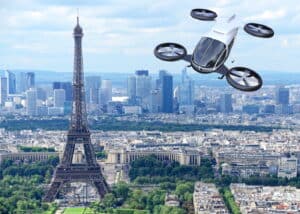
While electrifying road vehicles – cars, buses, bikes – are widely talked about, one type of EV is slowly paving its way into the world: eVTOL or electric vertical takeoff and landing vehicles. Like a helicopter, eVTOLs do not require a runway to land or takeoff, making it a good option for cities with a lack of wide open space. Los Angeles recently announced the Urban Air Mobility Partnership, a project that aims to establish an air taxi system, expanding the city’s transportation network and options. Other urban metropolises like Paris and London are also exploring the possibility of urban air mobility (UAM). What are cities set to gain from air taxis?
Why invest in upward air mobility?
Air taxis are envisioned as an alternative for inter-city or intra-city traveling, providing a faster, and hopefully more efficient, alternative to land travel. They are not meant to replace airplanes, but mainly focus on short distance trips.
There are a couple of advantages to this. First, this would hopefully reduce the amount of vehicles on roads, alleviating traffic congestion and moving some of it to the skies. This would then create a ripple effect, decreasing the noise and carbon emissions from vehicles, promoting a cleaner city.
Considering the environmental benefits, why not just invest more on electric public transportation like buses or trams? Another benefit of eVTOLs is that extensive infrastructure does not need to be in place for it to be adopted. Electric road vehicles would need charging stations, or overhead wiring to power or charge vehicles on the go – major undertakings for big cities. However, with eVTOLs, only transportation hubs need to be built, with no need to build roads or tracks to support it.
With access to fast and efficient mobility, UAM could potentially help decrease the population density of a city by encouraging people to move to the surrounding suburban areas and offering them quick ways to travel into the city for work.
The challenges ahead for Urban Air Mobility
As with any new technology or systems, there are challenges still to be overcome with urban air mobility. For instance, the safety of eVTOL technology needs to be proven to the public. While air travel does have a much lower accident rate than road travel, there are also many more risks involved. Especially as companies wish for these vehicles to be automated and work without the presence of a pilot. It might be a long while before enough trust can be built between this technology and its user.
Air traffic is also much more heavily regulated than road traffic, meaning that policies and regulations need to be ironed out and tested before this type of transportation can be safely opened to the public. Routes that will not disrupt airport traffic, for example, would need to be worked out.
Unlike cars, air taxis would not be able to take people directly point-to-point. Rather, it would be from one station to another. This means that integration between different modes of transport would need to be implemented in order to create an efficient and seamless travel experience. Otherwise, it would seem less convenient to travel by air only to have to switch vehicles to get to your final destination.
It is undeniable that electric vehicles are the future of transportation. With the rapid rate at which technology is improving, flying cars could soon be a normal fixture across a city’s skyline in the next 5 to 10 years.

